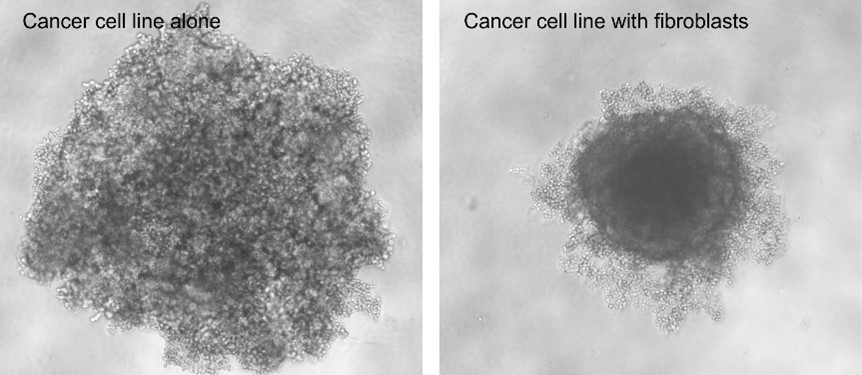BioSPHEER™ 3D cancer model selection
Established library of 3D cancer models
Bioneer offers an established and well-characterized collection of human in vitro 3D cancer models that are readily available for testing your drug candidates or cell therapy candidates.
Customizable BioSPHEER™ 3D cancer models
If you have a particular target cancer cell line of interest, we can tailor conditions for BioSPHEER ™ cancer spheroid formation and subsequent characterization using our comprehensive analytical toolbox.
Read more in our section “Latest scientific publications”:
BioSPHEER™ 3D cancer model selection
Established library of 3D cancer models
Bioneer offers an established and well-characterized collection of human in vitro 3D cancer models that are readily available for testing your drug candidates or cell therapy candidates.
Customizable BioSPHEER™ 3D cancer models
If you have a particular target cancer cell line of interest, we can tailor conditions for BioSPHEER ™ cancer spheroid formation and subsequent characterization using our comprehensive analytical toolbox.
Read more in our section “Latest scientific publications”:

Development of multicellular human spheroids by co-cultivating cancer cells and fibroblasts

Multicellular human spheroids showing how the cytokeratin-positive cancer cells cooperate with the actin-positive fibroblasts to form the unique structure of spheroids

Development of multicellular human spheroids by co-cultivating cancer cells and fibroblasts

Multicellular human spheroids showing how the cytokeratin-positive cancer cells cooperate with the actin-positive fibroblasts to form the unique structure of spheroids
Functional screening of different drug modalities
Assessing the ability of cancer drugs to kill cancer cells or efficiently inhibit cancer cell progression is essential in the evaluation of the functional properties of drug candidates in development.
For this purpose, Bioneer has established a series of readout assays that quantitatively determine the effect of drug candidates in our cancer models (both in 2D and 3D). These include:
- Viability assessment
- Apoptosis induction
- Cancer cell specific killing
Additionally, Bioneer can provide more sophisticated analyses by conducting cell population analyses using flow cytometry and/or molecular histology to document the functional effects on the cellular level of drug candidates in our human spheroid models.
The versatility of our BioSPHEER™ 3D cancer models, allow us to study drugs directly targeting cancer cells, drugs targeting tumor associated fibroblasts, drugs targeting immune cell subsets, or even drugs targeting extra cellular matrix (ECM) proteins. A wide range of drug modalities can thus be analyzed including standard cytotoxic compounds, biologics, antibody-drug-conjugates (ADCs), and immunotherapies such as checkpoint inhibitors and CAR T cells.
Drug target validation
Bioneer offers to validate new drug targets by introducing gene knock-outs (KO) into relevant cell lines or primary cells to mimic disease mechanisms and to model drug candidate responses.
Additionally, Bioneer can provide more sophisticated analyses by conducting cell population analyses using flow cytometry and/or molecular histology to document the functional effects on the cellular level of drug candidates in our human spheroid models.
For this purpose, Bioneer has established a series of readout assays that quantitatively determine the effect of drug candidates in our cancer models (both in 2D and 3D). These include:
- Viability assessment
- Apoptosis induction
- Cancer cell specific killing
Drug mode-of-action
Documentation of mode-of-action of new cancer drug modalities is an important step in validating drug candidates. Our BioSPHEER 3D cancer models offer a relevant and translatable tool to gain insights into mode-of-action.
Various immune-targeting cancer treatment strategies are aimed at preventing immunosuppressive phenotypes or stimulating an immune response (e.g. check-point inhibitors) against tumor cells in solid tumors, and therefore rely on cell-cell interplay in the tumor micro-environment. Furthermore, advanced therapy medicinal products (ATMPs) like CAR T-cell or NK cell therapies, can be evaluated in Bioneer’s 3D cancer models.
BioSPHEER™ 3D cancer models are suitable for studying various types of immune cell infiltration and immune cell activity, which is an essential part of the mode-of-action of immune cell focused therapies. Using our toolbox, we have demonstrated infiltration of human donor derived PBMCs and isolated cell subsets into our spheroids.
Bioneer’s cancer models also serve as a platform to study immune therapies targeting macrophages in tumors (tumor-associated macrophages (TAMs)). Using monocytes that spontaneously infiltrate our tumor spheroids and differentiate into macrophages, we can elucidate the diverse phenotypes in a cancer cell line-dependent manner and evaluate drug candidates such as those aimed at reprogramming macrophages.

Infiltration of T cells into cancer heterospheroids detected with immunofluorescence staining
Biomarker discovery and evaluation
To support biomarker related assessment of cancer model characteristics and associated drug effects, Bioneer’s toolbox also provides the opportunity to perform diverse molecular profiling analyses, including whole transcriptome profiling, more targeted gene expression profiling and multiplex cytokine monitoring.
For further information
please contact:
Philip Carlsen, Ph.D.
Business Development Manager

